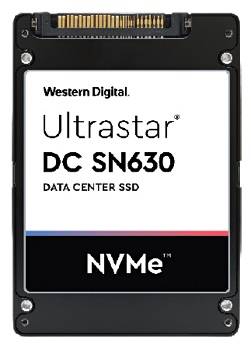This article is more than 1 year old
Western Digital sees storage sun rise in NVMe land... and slowly set on SATA, SAS SSDs
It's a time of long goodbyes
Western Digital (WD) has started to replace its SATA and SAS SSDs with faster NVMe drives.
Both the 2.5-inch Ultrastar DC SN630 and M.2 2280 (single-sided) format CL SN720 use WD and Toshiba's 64-layer 3D NAND configured for TLC (3bits/cell) using PCIe v3 4-lane and NVMe v1.3 interfaces.
WD is keen to say that it has produced all the drive components, from media up to the controllers and their software.
DC SN630
The DC SN630 is a data centre SSD with a version optimised for read-intensive work at 960GB, 1.92TB, 3.84TB and 7.68TB capacities. The mixed-use version has a lower capacity set due to over-provisioning at 800GB, 1.6TB, 3.2TB and 6.4TB.

WD Ultrastar DC SN630
Random read/write IOPS are not supplied by WD, though we're told the endurance is two full drive writes per day, presumably over a five-year lifetime, plus it has a five-year warranty, and up to two million hours mean time between failures (MTBF).
The read-intensive version does up to 363,700/55,820 random read/write IOPS and has 2.7/1.29GB/sec sequential read/write bandwidth.
Curiously, WD supplies highly detailed latency numbers for random reads – 130, 180, 230 and 230µs as capacity grows from 960GB through to 7.68TB. The endurance rating is lower at 0.8 drive writes/day with the same five-year warranty and up to two million hours MTBF rating.
The typical power consumption is 10.75w and it features instant secure erase support
For comparison, WD's HGST brand has a DC SS530 dual-port SAS drive running at 12Gbit/s also using 64-layer TLC 3D NAND. Its random read/write IOPS ratings of up to 440,000/320,000, putting the DC SN630 somewhat in the shade, particularly in the writing game.
The sequential read/write bandwidth numbers are up to 2.31/2.28GB/sec, again scoring better on writes than the SN630. NVMe on its own does not beat 12Gbit/s dual-port SAS in this instance.
CL SN720
We first came across WD's SN720 M.2 NVMe drive last March, but there was no announcement then of the CL SN720 model.
The CL SN720 drive is a boot or IoT edge drive. It comes in 256GB, 512GB, 1TB and 2TB capacities. Its random read/write IOPS are up to 330,00 and a remarkably low 2,700 - we had to check the datasheet twice to make sure. This is a drive for heavily read-intensive work.

WD Ultrastar CL SN720
Its sequential read/write bandwidth is still read-skewed, but less so, being up to 3.25/1.4GB/sec.
Read latency is 128µs and WD says the drive has 6X faster read and 2.5X faster write performance than the 1TB Ultrastar SA210 SATA SSD.
This is also based on 64-layer TLC 3D NAND, uses a 6Gbit/s SATA interface and comes in both 2.5-inch and M.2 2280 formats. Its random read/write IOPS are 64,000/5,000 and the sequential read/write bandwidth is 510/475MB/sec; much slower than the NVMe-using CL SN720 version.
We might also compare the CL SN720 to a recent gamer's flash drive from WD; the Black SN750. This has a heat sink covering its 64-layer TLC 3D NAND media and runs at 515,000/480,000 random read/write IOPS and 3.47/3.0GB/sec sequential read/writes; much faster and more balanced.
WD is building and configuring its drives to hit market sweet spots defined by performance, cost, power consumption and endurance.
The SN720 has self-encryption support; TCG OPAL 2.01, and instant secure erase. Both new drives are ready for denser 96-layer 3D NAND.
The SN630 is sampling with availability in March while the SN720 is shipping now. ®
